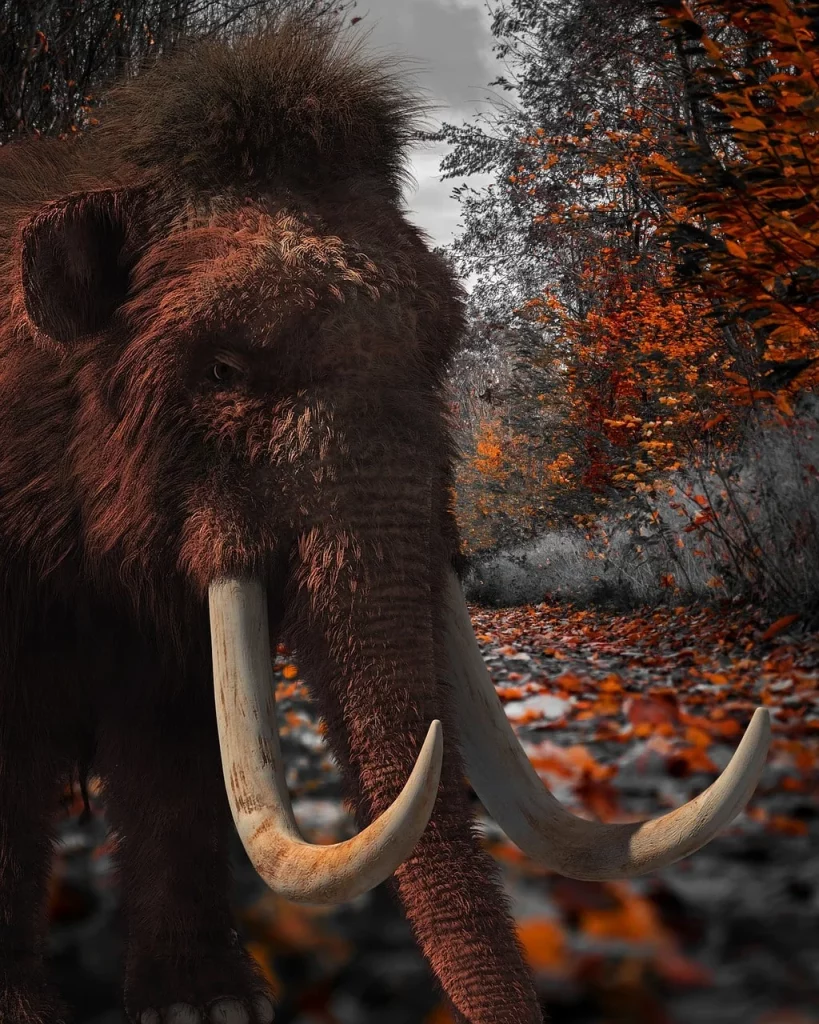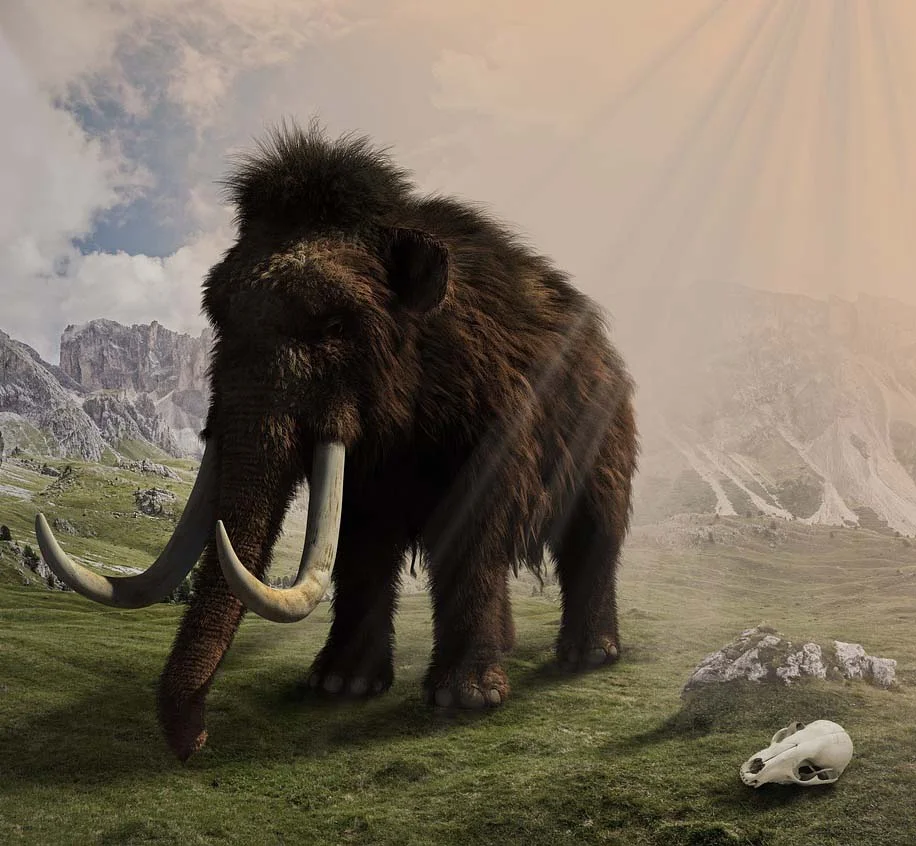What secrets do the long-gone mammoths hold about our Earth’s ancient history? These giant creatures, with their massive tusks and thick woolly coats, were once the rulers of the land. In this exciting exploration, we’ll take a closer look at these fascinating beasts.
Discover how mammoths lived, what they ate, and why they disappeared in a journey that will take you through the ice ages and into the heart of prehistoric life. Prepare to be enthralled by the tales of these majestic mammals!
Mammoths are the giants of our prehistoric imaginations.
David Attenborough
Mammoth Facts
As we embark on a journey through the fascinating world of mammoths, it’s important to absorb every detail. At the end of this article, I created a quiz, challenging you to demonstrate your expertise on these majestic creatures.
- Mammoths were members of the Elephantidae family, which also includes modern-day elephants.
- They first appeared in the Pliocene epoch about 5 million years ago.
- Mammoths had long, curved tusks, sometimes reaching over 15 feet in length.
- The Woolly Mammoth is the best-known species, famous for its thick, shaggy hair.
- Mammoths were primarily herbivores, feeding on a variety of plant life.
- The last known population of Woolly Mammoths lived on Wrangel Island in the Arctic Ocean.
- Mammoth fossils have been found on every continent except Australia and Antarctica.
- Their closest living relatives are the Asian Elephants.
- Pygmy mammoths evolved from larger species, adapting to island life with limited resources.
- Mammoths had a hump of fat behind their skulls to help them survive in cold climates.
- Their ears were smaller than modern elephants’, an adaptation to reduce frostbite and heat loss.
- Some mammoths had tusks that spiraled in complex patterns.
- Mammoth ivory is still found and used today, often in artwork and jewelry.

- They had a gestation period of about 22 months, similar to that of modern elephants.
- Woolly mammoths could grow up to 11 feet tall at the shoulder.
- Their teeth had a unique structure, adapted to grinding tough, fibrous food.
- Columbian mammoths were one of the largest species, weighing up to 10 tons.
- Mammoths likely had a social structure similar to today’s elephants, with matriarchal herds.
- Steppe mammoths are considered the ancestor of the Woolly Mammoth.
- Mammoths were hunted by early humans and Neanderthals for meat and materials.
- Preserved mammoth remains have been found with evidence of human butchery marks.
- The Yukagir Mammoth found in Siberia is one of the best-preserved mammoth specimens.
- Mammoths had four sets of teeth in their lifetime, much like modern elephants.
- The “Adams” Mammoth was the first near-complete mammoth skeleton recovered.
- Mammoths are believed to have died out due to a combination of climate change and human hunting.
- Cave art in Europe and Asia depicts mammoths, providing insights into their appearance and interaction with humans.
- The genome of the Woolly Mammoth has been sequenced, offering genetic insights.
- Scientists are researching de-extinction possibilities for mammoths using genetic engineering.

- Mammoth tusks grow in rings, each ring representing a year of life, similar to tree rings.
- The Channel Islands in California were home to the unique pygmy mammoth.
- There are over 500 locations in North America where mammoth remains have been found.
- The American Museum of Natural History has a famous exhibit featuring a Woolly Mammoth.
- Mammoths are often depicted in popular culture, notably in films and literature.
- La Brea Tar Pits in Los Angeles have yielded numerous mammoth fossils.
- Mammoths had a long, muscular trunk, used for grasping objects, fighting, and foraging.
- Their tusks were used for combat with predators, other mammoths, and foraging under snow.
- Mammoths had a layer of subcutaneous fat and a thick undercoat for insulation against the cold.
- The first recorded mammoth fossil discovery in North America was in 1705.

- Mammoth molars were highly ridged, making them ideal for grinding down grass and shrubbery.
- Mammoths likely had a lifespan of around 60-80 years, similar to modern elephants.
- The Woolly Mammoth is featured on the coat of arms of the Sakha Republic, Russia.
- Scientists use radiocarbon dating to determine the age of mammoth remains.
- Mammoth remains have been found in Siberian ice, exceptionally well-preserved.
- Ötzi the Iceman, a 5,300-year-old mummy, was found with a mammoth fur coat.
- The “Jarkov Mammoth” was discovered by a tusk hunter in Siberia in 1997.
- Cloning experiments aim to bring back mammoths or create modified elephants with mammoth traits.
- Mammoths had domed heads, larger in males, possibly used in mating displays or combat.
- The Mammoth Site in Hot Springs, South Dakota, is an active paleontological dig site.
- Mammoths are a keystone species in Ice Age paleoecology studies.
- The Mammoth Steppe was a vast ecosystem in the Northern Hemisphere where they thrived.
Mammoth Myths

Having explored the fascinating facts about mammoths, let’s now embark on a journey to distinguish reality from myth. Let’s uncover the actual truth behind some common myths.
- Mammoths and Elephants are the Same Species
Although mammoths and modern elephants share a common ancestor, they are distinct species. Mammoths, which lived during the Ice Age, were adapted to cold environments and had long, curved tusks and thick fur coats. - Humans Never Coexisted with Mammoths
Humans did coexist with mammoths, particularly during the last Ice Age. Evidence from cave paintings and archaeological findings indicates that early humans hunted mammoths for food and used their bones and tusks for tools and shelter. - Mammoths Were Only Found in North America
Mammoths were actually widespread and lived in various parts of the world, including Europe, Asia, Africa, and North America. Different species adapted to diverse environments, from icy tundras to grassy plains. - All Mammoths Were Giant in Size
While some mammoth species were enormous, reaching heights of up to 4 meters, not all were giants. The smallest known species, the Pygmy Mammoth, stood only about 1.8 meters tall – about the size of a modern Asian elephant. - Mammoths Died Out Solely Due to Climate Change
The extinction of mammoths was likely due to a combination of factors, including climate change and human hunting. As the climate warmed at the end of the Ice Age, their habitat shrank, and human hunting added extra pressure, leading to their eventual extinction.
No products found.
Mammoth Quotes

Mammoths, the colossal beings of the Ice Age, continue to fascinate us through the whispers of history. Below are my favorite quotes about them. You can send yours in the comments section so I can add them to the list.
The woolly mammoth’s story is a testament to nature’s wonder.
Jane Goodall
Jane Goodall, a world-famous primatologist and anthropologist, reflects on the woolly mammoth as an extraordinary example of the marvels of natural history.
In every mammoth bone, we find a chapter of Earth’s history.
Richard Dawkins
Richard Dawkins, an evolutionary biologist, emphasizes how mammoth fossils provide crucial insights into the Earth’s geological and evolutionary past.
The echo of the mammoth’s footsteps still resonates in modern science.
Neil deGrasse Tyson
Neil deGrasse Tyson, a celebrated astrophysicist, metaphorically suggests that the mammoth’s legacy continues to influence contemporary scientific understanding and exploration.
Mammoths are not just animals; they are the storytellers of our planet’s history.
Elizabeth Kolbert
Elizabeth Kolbert, a Pulitzer Prize-winning author known for her work on species extinction, portrays mammoths as crucial narrators in the vast epic of Earth’s history.
Studying mammoths is like turning the pages of a book written in the language of evolution.
Stephen Jay Gould
Stephen Jay Gould, a prominent paleontologist and evolutionary biologist, compares researching mammoths to reading an evolutionary narrative, written across millennia.
Mammoth FAQ

Let’s read some common questions about mammoths. This is the last section before the quiz, so read carefully if you want to prove that you are an expert.
- Are mammoths extinct?
Yes, mammoths are indeed extinct. The last of their kind, the woolly mammoths, disappeared from the Earth around 4,000 years ago, with their dwindling numbers primarily due to a combination of climate change and hunting by humans. - What did mammoths eat?
Mammoths were herbivores, meaning they primarily fed on plants. Their diet mainly consisted of grasses, leaves, and shrubs. During the Ice Age, they roamed the grasslands, munching on the available vegetation. - How large were mammoths compared to modern elephants?
Mammoths were generally larger than today’s elephants. The largest species, the Imperial mammoth, could reach up to 4 meters in height and weigh as much as 10 tons, which is bigger than the largest African elephants today. - Did humans ever coexist with mammoths?
Yes, humans did coexist with mammoths. In fact, evidence from cave paintings and archaeological finds shows that early humans hunted mammoths for food, used their bones and tusks for tools and building materials, and even depicted them in ancient art. - Are there any efforts to bring mammoths back?
In recent years, there has been talk about using genetic engineering to bring back mammoths, or at least a mammoth-elephant hybrid. This involves using DNA from mammoths preserved in ice and integrating it with the DNA of modern elephants. However, this is a complex and controversial field, still in its early stages.
No products found.
Mammoth Quiz

Welcome to the Mammoth Quiz! If you don’t score any points, don’t be surprised if a woolly mammoth mistakes you for a prehistoric snack!
Conclusion
As we close this journey through the fascinating world of mammoths, let’s pause and reflect on their incredible journey through time. These majestic creatures, which roamed the earth thousands of years ago, still capture our imagination today.
Their existence and eventual extinction remind us of the ever-changing nature of our planet and its inhabitants. How different would our world be if mammoths still roamed the land? Imagine walking in a forest and seeing a mammoth in the distance! Let’s cherish the knowledge and lessons they’ve left behind in their fossilized footsteps.
So let’s close this adventure with a question: If you could take a mammoth to any modern-day place, where would you take it and why? A shopping mall, perhaps? Let me know your crazy ideas in the comments.
4 Sources Used For This ArticleMammoths – G Files
Where did woolly mammoths live? – Anstoal
What Are The Differences Between Mammoths And Elephants? – Dinosaur Facts


